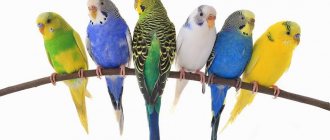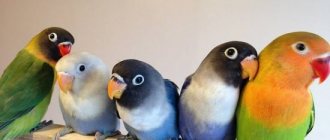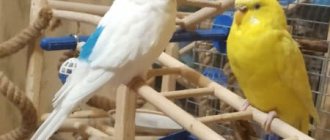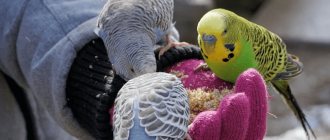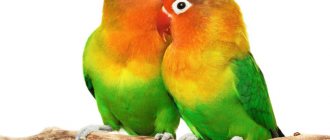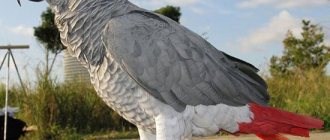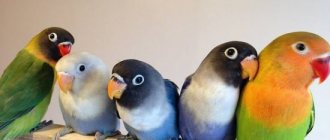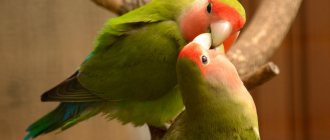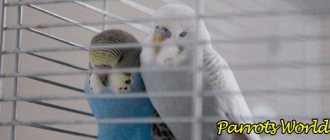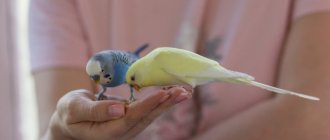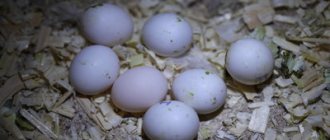Each pet perceives the world differently. Cats detect all shades of gray, dogs do not recognize red and orange, rats do not recognize yellow. How do parrots see? For them, vision is the main sense organ with which they navigate in space. Winged birds are excellent at noticing small details located at a far distance. You are unlikely to catch them by surprise.
How parrots see
In both humans and parrots, the basic perception of the world around us, the ability to navigate in space, occurs through vision. The bird's eyes - this main organ of vision - are located on the sides of the head, which allows the birds to see around them at 340°. Thanks to their vision, parrots are able to see different pictures with each eye.
If you have observed how budgies see, you may have noticed that their eyes move independently of each other. They are able to fix their gaze on objects in different corners of the room. It is not surprising that birds become very frightened if an object they observe suddenly disappears in one place and immediately materializes in another.
Important! When near the bird, do not make sudden movements, move smoothly so that it has time to follow your movements.
Relative to the head, the eyes of these birds are very large, which allows you to examine any object in the smallest detail and detail, distinguishing it from the overall picture.
How do parrots see close objects? They see everything that is close to them rather poorly. Having taken a good look at the food from afar, the birds, already close to it, feel it with the tip of their beak.
Another feature of the vision of budgerigars is the speed of perception . These birds are able to look at about 150 frames per second. Such a high speed of perception of visual information allows you to react almost instantly to danger.
A pet flying around a room is able to see in three to four seconds everything that interests him: where the cage, water and food are, what objects he may encounter on the way, where is the best place to land and who is in the room.
Nuances of seeing wavy birds
Birds have eyes on the sides of their heads, so they have a unique viewing angle of 360 degrees.
Birds have monocular vision, so they see a separate picture with each eye.
Birds have the ability to move each eye separately. They can fix their gaze on two different objects that are located in opposite directions.
Therefore, if one object is moved, this often leads to fright. When establishing contact with your pet, it is not recommended to make sudden movements.
The wavy eye consists of the following parts:
- eyeball;
- eyelids;
- tear ducts
A significant element of the eye is the lens, which allows the bird to focus on any object.
Are the colors different?
While admiring the bright plumage of their pet, many owners do not suspect that in fact these nimble birds are much more beautiful - the color of their feathers is much richer and more intense. The human eye is simply not capable of capturing the entire possible color gamut.
Parrots distinguish colors much better than humans. And all because they have more cells involved in the perception of colors and shades. We see millions of colors thanks to the brain's ability to absorb blue, red and green colors. Parrots can also see ultraviolet light . Can you imagine the range of colors these little birds see?
Unfortunately, for now we can only guess what exactly and how budgies see, because we don’t know what it’s like to see objects in the ultraviolet spectrum.
To show the difference in color perception, scientists compare the ability to distinguish between the variety of colors of people and birds, using the analogy of a tetrahedron (tetrahedron) . Where one side of the polyhedron is the abilities of the human eye, and the entire tetrahedron, all four sides are the abilities of the visual organs of birds:
Tetrahedron
Attention! Domestic birds experience health problems when they are unable to see sufficient amounts of ultraviolet light.
Ultraviolet light is of great importance for birds. Due to a lack of sunlight and shorter daylight hours than their wild relatives, domesticated parrots get sick. Consequences of insufficient lighting:
- Birds begin to develop health problems because their bodies lack vitamin D, which is necessary for proper bone growth.
- The quality of vision decreases - they begin to see the world around them in black and white, bright colors are no longer available to them, which makes such pets lethargic and apathetic.
Behavior and diet
The photo shows a gray and white cockatiel.
Corellas love to watch people's actions and are easily involved in games; they are very active and curious. However, to maintain such energy, birds need the right diet.
In the wild, parrots prefer the leaves of eucalyptus trees and shrubs, juicy fruits and herbs. They also love nectar, seeds, resin and young bark of many woody plants.
At home, they should receive a similar diet. It should include fresh vegetables, fruits, herbs and grains. Occasionally it is necessary to add a boiled egg and low-fat natural cottage cheese to the food.
Can parrots see in the dark?
What kind of vision do parrots living in the wild have? Due to the fact that many dangers await birds, they see well during the day and at dusk, but in pitch darkness they experience temporary blindness.
Domestic budgies cannot see in the dark or at dusk. This happened evolutionarily, because they do not have an urgent need to be on guard all the time. The weaker the lighting in the room, the worse the birds see and navigate in space. Therefore, it is important to cover the pet’s cage with thick fabric at night so that nothing frightens it or causes the disoriented bird to rush around its house.
Due to the sensitivity of a parrot's eyes to light and the sensitivity of its nervous system, you should not suddenly turn on the light in a room where the bird is sleeping peacefully. This is extremely stressful for her. Make some noise first to prepare your pet a little, and only then turn on the lights.
What can a parrot see?
Birds easily distinguish and focus on all surrounding objects. While flying around the room, they notice all the changes, and also easily build a route without hitting any elements.
In about 5 seconds, the bird determines the location of each person, pet or piece of furniture during its flight. Therefore, they can easily land on a picture, shelf or other element without knocking over foreign objects along the way.
Does a parrot bother you at night?
Not really
How does a male see a female?
The amazing ability to see ultraviolet light helps parrots see a member of the opposite sex and form a pair for breeding offspring.
In many species of parrots, males are brighter in color than females. In those species where the color of both sexes is almost the same, the female is always duller than the male. There are species of birds that, to human eyes, have completely identical colors. However, even here, in 9 cases out of 10, birds unmistakably recognize an individual of the opposite sex by plumage, although for us there is visually no difference between a male and a female.
What types of cockatiels are there?
The natural color of these parrots is represented by a gray body, yellow head and bright orange cheeks. During artificial breeding, new, brighter colors were developed. Now you can find cockatiels with the following colors from breeders:
- White. There are two types: albino and just white. Differences in eye color. Albinos will have red eyes, while whites will have black eyes. Let's allow a light cream shade of plumage. The head and crest remain yellow.
- Whitewing. This color is characterized by white flight feathers, and the main feathers remain gray.
- Light grey. Somewhat lighter than usual gray individuals. The yellow head and crest are preserved.
- Pearl grey. In this color the feather has uneven pigmentation. The very edge is a rich gray color, and the middle of the feather is white. You can find individuals that have a cinnamon or yellow tint instead of white. Only females retain this unusual coloration for their entire lives. Males change color after molting.
- Cinnamon. The main plumage can take on various shades of brown.
- Dark yellow. In this case, the color varies from light cream to dark yellow.
- Lyutino. This color implies a yellow body color with white spots on the wings. The cheeks are bright orange.
- Blackwing. Representatives of this color have a back and tail that are much darker than the main gray color of the body. The wings are also darker and have white spots.
- Black. The entire cockatiel is a rich dark gray color. The breast is almost black in color; there are light spots on the wings. The cheeks are dark orange and may have a few black feathers.
The most common colors: gray and lutino - Sheki or spotted. The main shade of these representatives is gray. There are many white spots on the wings. The head is white, the tail should be white-yellow. Spotted cockatiels have a subspecies - the harlequin. In such birds, only the wings remain gray, the head and crest are yellow, and the main part of the feathers is white.
By crossing different colors of cockatiels, unusual and original colors are increasingly being obtained. But most of them are still gray. This coloring is considered natural. The brightest colors are obtained by crossing spotted representatives with other pigment carriers.
Can a parrot recognize itself in the mirror?
Many bird owners are curious about how the parrot sees its reflection in the mirror - thinking that it is a friend with whom you can communicate, or does it recognize itself in it? The vast majority of experiments have shown that birds do not recognize themselves in a mirror. They happily coo at their reflection, confident that they have found another individual of their species.
And only one experiment on magpies showed that magpies can recognize themselves in the mirror, and only two out of five were capable of this.
A mirror for a parrot kept alone is great entertainment and an escape from boredom. Many solitary birds become sad and sick, and begin to pluck their feathers. However, this does not happen to those birds whose cage contains a mirror.
Even if you later decide to make a friend for your parrot, the mirror will help you understand how strong a couple your pet will make. Observations of parrots made it clear that sociable and peace-loving birds spend a lot of time with the mirror. Such people then create strong couples, becoming strongly attached to their partner.
The living world of our planet is amazing. From this video you will learn how different living creatures, including parrots, see the world around them:
Migratory or wintering
The photo shows a yellow cockatiel on a branch.
Corellas are capable of covering considerable distances, but they are not migratory birds. In winter in Australia, the thermometer does not drop below 0°C, so birds can easily cope with this time of year. In addition, winter is considered the rainy season, when plants receive sufficient moisture and increase their growth, providing food for birds.
Cockatiels were forced into Europe on ships, but not a single bird left Australia on its own.
Singing
Both in natural and at home conditions, the cockatiel sings very melodiously, accurately repeating the sounds it hears. Nymphs easily copy the sounds of alarm clocks, household appliances and other pets. But teaching them to talk is a little more difficult. To do this, you need to show self-control and patience.
Male cockatiels sing especially beautifully during the mating season. At this point, it is easiest to teach the cockatiel to repeat sounds, as well as melodies. To do this, you should hum or whistle simple songs several times a day.
